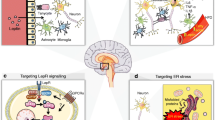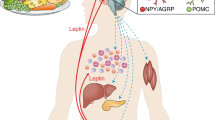Abstract
Leptin is a circulating hormone that is secreted in proportion to fat mass. It can reduce bodyweight by activating signalling molecules in the brain. Leptin appears to affect bodyweight primarily by decreasing food intake; there is no direct evidence that it significantly influences energy expenditure in humans. Its discovery in 1994 raised the possibility that it may be a useful, satiety-inducing, anti-obesity drug. However, treating obese patients with leptin alone does not induce substantial bodyweight loss because most obese patients are insensitive to leptin and are not leptin deficient. In combination with diet therapy, however, leptin treatment has the potential to eliminate the dramatic fall in circulating leptin levels (and the subsequent increase in hunger) caused by calorie restriction. Used in this manner, leptin may play a very useful role in the maintenance of body-weight loss. In the future, leptin analogues and the development of compounds that increase leptin sensitivity may also prove to be valuable therapeutic approaches for obesity.
Similar content being viewed by others
References
Zhang Y, Proenca R, Maffei M, et al. Positional cloning of the mouse obese gene and its human homologue. Nature 1994; 372: 425–32
Montague CT, Prins JB, Sanders L, et al. Depot- and sex-specific differences in human leptin mRNA expression: implications for the control of regional fat distribution. Diabetes 1997; 46 (3): 342–7
Houseknecht KL, Mantzoros CS, Kuliawat R, et al. Evidence for leptin binding to proteins in serum of rodents and humans: modulation with obesity. Diabetes 1996 Nov; 45 (11): 1638–43
Patel N, Brinkman-Van der Linden EC, Altmann SW, et al. OB-BPl/Siglec-6: a leptin- and sialic acid-binding protein of the immunoglobulin superfamily. J Biol Chem 1999; 274: 22729–38
Birkenmeier G, Kampfer I, Kratzsch J, et al. Human leptin forms complexes with alpha 2-macroglobulin which are recognized by the alpha 2-macroglobulin receptor/low density lipoprotein receptor-related protein. Eur J Endocrinol 1998; 139: 224–30
Li C, Ioffe E, Fidahusein N, et al. Absence of soluble leptin receptor in plasma from dbPas/dbPas and other db/db mice. J Biol Chem 1998; 273 (16): 10078–82
Wang J, Liu R, Liu L, et al. The effect of leptin on Lep expression is tissue-specific and nutritionally regulated. Nat Med 1999; 5: 895–9
Martin LJ, Jones PJ, Considine RV, et al. Serum leptin levels and energy expenditure in normal weight women. Can J Physiol Pharmacol 1998; 76: 237–41
Larsson H, Elmstahl S, Berglund G, et al. Evidence for leptin regulation of food intake in humans. J Clin Endocrinol Metab 1998 Dec; 83 (12): 4382–5
Kennedy A, Gettys TW, Watson P, et al. The metabolic significance of leptin in humans: gender-based differences in relationship to adiposity, insulin sensitivity, and energy expenditure. J Clin Endocrinol Metab 1997; 82: 1293–300
Demerath EW, Towne B, Wisemandle W, et al. Serum leptin concentration, body composition, and gonadal hormones during puberty. Int J Obes Relat Metab Disord 1999; 23: 678–85
Schubring C, Siebler T, Kratzsch J, et al. Leptin serum concentrations in healthy neonates within the first week of life: relation to insulin and growth hormone levels, skinfold thickness, body mass index and weight. Clin Endocrinol (Oxf) 1999;51: 199–204
Moller N, O’Brien P, Nair KS. Disruption of the relationship between fat content and leptin levels with aging in humans. J Clin Endocrinol Metab 1998; 83: 931–4
Franceschini R, Corsini G, Cataldi A, et al. Twenty-four-hour variation in serum leptin in the elderly. Metabolism 1999; 48: 1011–4
Cioffi JA, Shafer AW, Zupancic TJ, et al. Novel B219/OB receptor isoforms: possible role of leptin in hematopoiesis and reproduction. Nat Med 1996; 2: 585–9
Kielar D, Clark JS, Ciechanowicz A, et al. Leptin receptor isoforms expressed in human adipose tissue. Metabolism 1998; 47: 844–7
McCowan KC, Chow JC, Smith RJ. Leptin signaling in the hypothalamus of normal rats in vivo. Endocrinology 1998; 139: 4442–7
Barzilai N, Wang J, Massilon D, et al. Leptin selectively decreases visceral adiposity and enhances insulin action. J Clin Invest 1997; 100: 3105–10
Pelleymounter MA, Cullen MJ, Baker MB, et al. Effects of the obese gene product on body weight regulation in ob/ob mice. Science 1995; 269: 540–6
Farooqi IS, Jebb SA, Langmack G, et al. Effects of recombinant leptin therapy in a child with congenital leptin deficiency. N Engl J Med 1999; 341: 879–84
Salbe AD, Nicolson M, Ravussin E. Total energy expenditure and the level of physical activity correlate with plasma leptin concentrations in five-year-old children. J Clin Invest 1997; 99: 592–5
Toth MJ, Sites CK, Poehlman ET. Hormonal and physiological correlates of energy expenditure and substrate oxidation in middle-aged, premenopausal women. J Clin Endocrinol Metab 1999; 84: 2771–5
Nicklas BJ, Toth MJ, Poehlman ET. Daily energy expenditure is related to plasma leptin concentrations in older African-American women but not men. Diabetes 1997; 46: 1389–92
Levine JA, Eberhardt NL, Jensen MD. Role of nonexercise activity thermogenesis in resistance to fat gain in humans. Science 1999; 283: 212–4
Levine JA, Eberhardt NL, Jensen MD. Leptin responses to overfeeding: relationship with body fat and nonexercise activity thermogenesis. J Clin Endocrinol Metab 1999; 84: 2751–4
Doring H, Shcwarzer K, Nuesslein-Hildesheim B, et al. Leptin selectively increases energy expenditure of food-restricted lean mice. Int J Obes Relat Metab Disord 1998; 22: 83–8
Mantzoros CS, Flier JS, Rogol AD. A longitudinal assessment of hormonal and physical alterations during normal puberty in boys. V. Rising leptin levels may signal the onset of puberty. J Clin Endocrinol Metab 1997; 82: 1066–70
Nakata M, Yada T, Soejima N, et al. Leptin promotes aggregation of human platelets via the long form of its receptor. Diabetes 1999; 48: 426–9
Liu L, Karkanias GB, Morales JC, et al. Intracerebroventricular leptin regulates hepatic but not peripheral glucose fluxes. J Biol Chem 1998; 273: 31160–7
Shimomura I, Hammer RE, Ikemoto S, et al. Leptin reverses insulin resistance and diabetes mellitus in mice with congenital lipodystrophy. Nature 1999; 401: 73–6
Friedman JM, Halaas JL. Leptin and the regulation of body weight in mammals. Nature 1998; 395: 763–70
Festa A, Shnawa N, Krugluger W, et al. SM. Relative hypoleptinaemia in women with mild gestational diabetes mellitus. Diabet Med 1999; 16: 656–62
Ravussin E, Pratley RE, Maffei M, et al. Relatively low plasma leptin concentrations precede weight gain in Pima Indians. Nat Med 1997; 3: 238–40
Montague CT, Farooqi IS, Whitehead JP, et al. Congenital leptin deficiency is associated with severe early-onset obesity in humans. Nature 1997; 387: 903–8
Strobel A, Camoin TIL, Oxata M, et al. A leptin missense mutation associated with hypogonadism and morbid obesity. Nat Genet 1998; 18: 213–5
Clement K, Vaisse C, Lahlou N, et al. A mutation in the human leptin receptor gene causes obesity and pituitary dysfunction. Nature 1998; 392: 398–401
Caro JF, Kolaczynski JW, Nyce MR, et al. Decreased cerebro-spinal-fluid/serum leptin ratio in obesity: a possible mechanism for leptin resistance. Lancet 1996; 348: 159–61
Seeley RJ, Yagaloff KA, Fisher SL, et al. Melanocortin receptors in leptin effects [letter]. Nature 1997; 390: 349
Zakrzewska KE, Cusin I, Sainsbury A, et al. Glucocorticoids as counterregulatory hormones of leptin: toward an understanding of leptin resistance. Diabetes 1997; 46: 717–9
Hinney A, Shmidt A, Nottebom K, et al. Several mutations in the melanocortin-4 receptor gene including a nonsense and a frameshift mutation associated with dominantly inherited obesity in humans. J Clin Endocrinol Metab 1999; 84: 1483–6
Emilsson V, Arch JR, de Groot RP, et al. Leptin treatment increases suppressors of cytokine signaling in central and peripheral tissues. FEBS Lett 1999; 455: 170–4
Bjorbaek C, Elmquist JK, Frantz JD, et al. Identification of SOCS-3 as a potential mediator of central leptin resistance. Mol Cell 1998; 1: 619–25
Barr VA, Lane K, Taylor SI. Subcellular localization and internalization of the four human leptin receptor isoforms. J Biol Chem 1999; 274: 21416–24
Heymsfield SB, Greenberg AS, Fujioka K, et al. Recombinant leptin for weight loss in obese and lean adults: a randomized, controlled, dose-escalation trial. JAMA 1999; 282: 1568–75
Keim NL, Stern JS, Havel PJ. Relation between circulating leptin concentrations and appetite during a prolonged, moderate energy deficit in women. Am J Clin Nutr 1998; 68: 794–801
Geldszuz R, Mayr B, Horn R, et al. Serum leptin and weight reduction in female obesity. Eur J Endocrinol 1996; 135: 659–62
Mueller WM, Gregoire FM, Stanhope KL, et al. Evidence that glucose metabolism regulates leptin secretion from cultured rat adipocytes. Endocrinology 1998; 139: 551–8
Mantzoros CS, Qu D, Frederich RC, et al. Activation of β3 adrenergic receptors suppresses leptin expression and mediates a leptin-independent inhibition of food intake in mice. Diabetes 1996; 45: 909–14
Wisse BE, Campfield LA, Marliss EB, et al. Effect of prolonged moderate and severe energy restriction and refeeding on plasma leptin concentrations in obese women. Am J Clin Nutr 1999; 70: 321–30
Halle M, Berg A, Garwers U, et al. Concurrent reductions of serum leptin and lipids during weight loss in obese men with type II diabetes. Am J Physiol 1999; 277: 277–82E
Acknowledgements
Anne Thorburn is supported by the National Health and Medical Research Council of Australia. Deborah Ainslie is the recipient of a Melbourne University Research Scholarship. Barbara Fam is the recipient of an Australian Postgraduate Award.
Author information
Authors and Affiliations
Corresponding author
Rights and permissions
About this article
Cite this article
Thorburn, A.W., Ainslie, D.A., Fam, B. et al. Leptin in the Pathophysiology of Human Obesity and the Clinical Potential of Leptin-Based Therapy. BioDrugs 13, 391–396 (2000). https://doi.org/10.2165/00063030-200013060-00002
Published:
Issue Date:
DOI: https://doi.org/10.2165/00063030-200013060-00002




